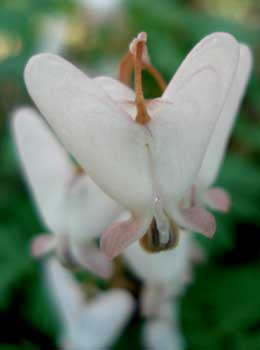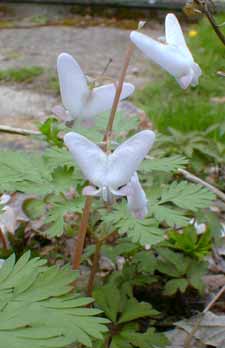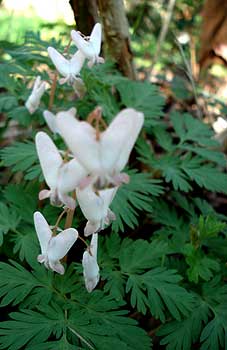
Dutchman's Breeches
"The old dutchman's breeches
had been freshly pressed,
And bright colored lilies
most fragrantly dressed."
-Emma Putnam Bancroft,
1919
1919
 Though most often called Dutchman's Breeches, Dicentra cucullaria has several regional names, including White Hearts, Boy Britches, Little Boy Plant, Breeches Flower, Kittens' Britches, Bachelor's Pants, Elves' Trousers, Soldier's Caps, Monk's Heads, Butterfly Banners, Eardrops, Indian Boys & Girls, Staggerweed, or Little Blue Staggers.
Though most often called Dutchman's Breeches, Dicentra cucullaria has several regional names, including White Hearts, Boy Britches, Little Boy Plant, Breeches Flower, Kittens' Britches, Bachelor's Pants, Elves' Trousers, Soldier's Caps, Monk's Heads, Butterfly Banners, Eardrops, Indian Boys & Girls, Staggerweed, or Little Blue Staggers.The names Little Blue Staggers or Staggerweed derive from its ability to induce drunken disorientation if cattle graze on it, due to an opiate in the poppy-related genus. Most of its names allude to the unusual shape of the tiny flowers.
I obtained a pot of dirt in October 2002 that allegedly had D. cucullaria in it invisibly. When I was planting it, I could not detect any root or bulbil or seed or anything at all in the very loose soil, so I began to suspect I had obtained a pig in a poke.
 Throughout 2003, nothing grew in its spot. Toward autumn I decided not to leave the spot bare, so translplanted a fern to that location, when low & beheld, I dug up a tiny cluster of rice-seed-like bulbs.
Throughout 2003, nothing grew in its spot. Toward autumn I decided not to leave the spot bare, so translplanted a fern to that location, when low & beheld, I dug up a tiny cluster of rice-seed-like bulbs.Guessing these were the Dutchman's Breeches, I replanted them at the shade-edge of the Paperbark Maple. Late the following March in 2004, a tiny plant appeared, blooming almost as soon as it had a couple of leaves.
The second photo shows the first flowers which took two full years to show themselves. In the meantime, I had already decided to plant more of it, & in October 2003 I bought two packages of peatmoss dust in a package that purported: "Each packet contains one plant root," though no "root" was evident. Following instructions I dumped the peat into three inch deep holes -- against a fence in a shade garden next to the Vining Yellow Bleeding Hearts & Arends's Monkshood. Nothing ever grew there.
But that original planting comes back every year. The first photo & the third photo are from May 2009.
It provides a very attractive winter's-end & early-spring groundcover of short blue-green ferny leaves between four inches or rarely a foot tall. It raises its late March, April & May blooms above the clump on leafless stems. Several small predominantly white flowers hang from each stem, looking like pantaloons upside down to dry.
A native wildflower common throughout the eastern United States, it is rare but present even here in the Pacific Northwest. In the garden it is a charming if transient presence. It wants part shade to full shade, in moist well draining humousy soil. It is dormant in summer & winter, & the root can rot if the soil remains too damp in winter. Because it remains dormant so long, its location must be carefully marked or it will be accidentally dug up in the course of gardening.
The flowers wilt almost immediately upon picking them so should be left in the yard. A clump may self-seed, but can take two years to germinate, & another year or two on top of that to bloom.
Among the Menomini Indians this plant was regarded as a marriage charm. Young men would throw the plant at a maiden, or chew the plant then breathe on her, so that she would want to follow him. Which was as good an excuse as any, if he was cute.